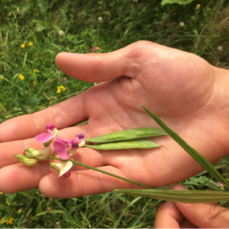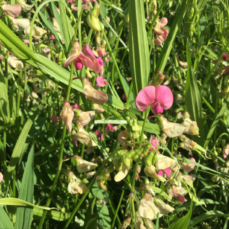
Photo credit: Bob Brett
Management Category
Squamish
Whistler
Pemberton
Vectors of Spread
Synonyms
Flat vetchling, narrow-leaved pea, wood pea, perennial pea, narrow-leaved everlasting peavine
ID Characteristics
Flowers: White, pink or red flowers that grow in clusters of 4 – 9 flowers on long stalks. The petals are two different sizes, but the flowers are symmetrical (zygomorphic), the only exception being the protruding seed pod at the center. The petals have a lateral, wing-like shape.
Stems: Hairless tendril-like stems that are constantly climbing. Stems grow about 1.8 – 2 m long.
Leaves: Blue-green, smooth compound leaves that grow in pairs, interrupted only by branched tendrils. These narrow leaf stalks are vaguely egg-shaped, approximately 10 cm long and 2 – 3 cm across.
Fruits: Seed pods are bean-like (4 – 6 cm long). The seeds resemble edible peas, becoming dark grey or even black at maturity. Each pod typically contain 10 – 20 seeds.
Similar Species
Native
Marsh peavine (Lathyrus palustris): Found along mudflats and tidal marshes, lakesides and streambanks, this delicate peavine is scattered across coastal B.C. Its flowers form stalked clusters of pink to bluish-purple blooms, and leaves are a broad, dark green.

Invasive
Broad-leaved peavine (Lathyrus latifolius): Found among dry thickets and roadsides, this invasive peavine most commonly gets into the environment as an escaped garden ornamental. Its flowers cluster in groups of 4 – 9, with rose-tinged pink petals and pairs of leaflets growing out from the stems.
You can learn more about the similarities and differences between broad-leaved peavine and flat pea in this comparison factsheet.

Habitat and Origin
Introduced from Eurasia flat pea was used as a garden ornamental and an erosion control agent to begin a soil improvement process and prevent the growth of other invasive plants.
Although this warped weed is known to escape gardens, flat pea is primarily found in disturbed areas with full sun and dry soil. This plant thrives in dry thickets, exposed clearings, roadsides and waste disposal sites along low-elevation areas.
How it Spreads
Flat pea spreads through both seed production and root rhizomes. With deep, horizontal roots, the plant produces new growth every spring. Mature plants also produce seed pods that twist and eject the seeds up to 10 m away.
Flat pea is used as a garden ornamental, and may be sold in seed mixes. Roadside mowing also spreads the plant to new locations. Lastly, seeds can be transported to new areas through human activities, water, and animals.
Impacts
Ecological:
- Chokes out native plant life, thus reducing biodiversity.
- Forms dense, impenetrable monocultures.
- Impacts groundcover species, shrubs, and trees.
Economic:
- Reduces land value.
Health:
- Toxic to humans and livestock due to a high concentration of diaminobutyric acid (DABA).
- It can cause lathyrism if ingested in large quantities. This disease affects primarily horses, and symptoms include muscle weakness, stiffness and loss of muscle control.
Prevent the Spread
Flat pea is found in the Sea to Sky region, but with a limited distribution. The goal is to eradicate this species from the region, and to prevent new introductions.
Learn to identify flat pea: use the images presented in this profile page to learn how to identify flat pea.
What to do if you spot it: You can report any flat pea sighting by visiting our reporting page.
DO:
- Regularly monitor properties for weed infestations.
- Report any potential flat pea sightings to SSISC.
- Ensure soil and gravel are uncontaminated before transport.
- Check wildflower mixes to ensure that they do not contain flat pea.
- Ensure that all plant parts are disposed of in a garbage bag if found in floral arrangements, land waste, or weed debris to prevent seeds from spreading.
DO NOT:
- Pick and collect flat pea blooms.
- Mow over established flat pea infestations.
- Unload, park or store equipment or vehicles in infested areas; remove plant material from any equipment, vehicles, or clothing used in such areas and wash equipment and vehicles at designated cleaning sites before leaving infested areas.
- Plant flat pea in a garden, no matter how well-contained its enclosure may seem.
- Move soil, land waste, or other weed debris that has been contaminated with flat pea.
- Dispose of flat pea in the compost.
Control
Mechanical
- Regularly hand-pulling can control small infestations, but it also encourages seed germination.
- Cutting the plant to the ground and covering the infested area with woven plastic fabric (tarp) has proven effective; however, this method requires the ground to be covered for at least 2 years and will kill all plants underneath.
Chemical
- Triclopyr, dicamba, and picloram can be effective flat pea control.
- Note, however, that Picloram is not suitable for wet, coastal soils.
- We recommend that any herbicide application is carried out by a person holding a valid BC Pesticide Applicator Certificate. Before selecting and applying herbicides, you must review and follow herbicide labels and application rates; municipal, regional, provincial and federal laws and regulations; species-specific treatment recommendations, and site-specific goals and objectives.
Cultural
Flat pea is palatable and non-toxic to goats, which can be used for partial grazing control.
Sea to Sky Distribution
Flat Pea Factsheet
Having trouble viewing the factsheet? Don’t worry, all the information is included on this page. You can also contact us with any questions.
Additional Resources
References
- Electronic Atlas of the Flora of British Columbia, Lathyrus sylvestris
- Invasive Plant Atlas of the United States, Flat peavine (Lathyrus sylvestris)
- Jefferson County Noxious Weed Control Board, Best Management Practices of Everlasting Peavine (Lathyrus latifolius) and Flat Pea (Lathyrus sylvestris)
- Midwest Invasive Species Information Network, Flat pea (Lathyrus sylvestris)
- NatureGate, Narrow-leaved Everlasting Pea (Lathyrus sylvestris)
- Plants for A Future, Lathyrus sylvestris
- United States Department of Agriculture, Perennial Pea (Lathyrus latifolius)
- United States Department of Agriculture Natural Resources Conservation Service, Lathyrus sylvestris












